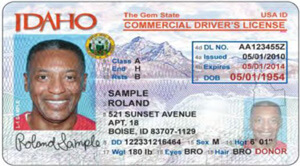- Updated for March 2025
- Based on 2025 ID commercial driver's license manual
Free Idaho CDL Permit Practice Test: General Knowledge 2025
Are you studying to pass the official Idaho General Knowledge test so you can become eligible for a Commercial Learner’s Permit (CLP)? Worried that you may not pass without some additional help? We’re glad you chose us to help you, because we’re sure you won’t be disappointed. You’re not the only one who hasn’t mastered commercial driving theory by just reading the official Idaho Commercial Driver’s License Manual (Idaho CDL Handbook 2025). That’s why many other aspiring commercial drivers have decided to supplement their reading of the manual with other study tools.
This free Idaho CDL permit practice test is based on the official manual, just like the official General Knowledge test. And the practice test is up to date as of March, 2025. Practicing with it will help reinforce what you read in the manual. In addition, each of the 50 practice questions comes with a helpful hint and an explanation of the correct answer. The practice questions on this test will assess your knowledge of such topics as basic maneuvers, cargo management, emergency preparedness, and pre-trip inspections. Keep practicing your knowledge with as many of our practice tests as you can, as often as you can, until you feel confident that you’ve mastered the material and can ace the official General Knowledge test.
There’s one other major test you must take for a CLP: a medical examination. Once you pass those tests and meet some other requirements, you can obtain a CLP and start practicing commercial driving so you can pass the skills test for your Commercial Driver’s License (CDL). The skills test consists of three parts: basic vehicle maneuvers (such as backing), a pre-trip inspection of the vehicle, and a road test.
Once you get your CDL, you can start taking advantage of profitable opportunities in commercial driving. Idaho produces huge quantities of agricultural products, most famously potatoes, but also wheat, barley, and dairy products, all of which require truck drivers to transport. Folks who don’t live in Idaho may think of it as an agricultural state, but the state also has a large and growing industrial sector, especially in science and technology. High-tech businesses also require truck drivers to transport equipment and supplies to them as well as transport their finished products.
Another important economic sector is tourism. Idaho attracts visitors all year round to its national parks, ski resorts, and other tourist and recreational areas, creating a constant demand for bus drivers.
Major commercial routes include Interstates 84 and 90, U.S. Route 95, and State Highway 55.
- Perfect for first-time and renewal CDL/CLP applicants, and those adding endorsements
- Triple-checked for accuracy
What you need to know

What to expect on the actual ID DMV exam
questions
correct answers to pass
passing score
List of questions (classic view)
- Which of the following commodities are you NOT allowed to legally transport intrastate (in Idaho) without a DOT medical card in your possession?
- What is the definition of a hazard?
- You should inspect wheel bearing seals for
- How long does it take for a typical tractor-trailer to clear a double railroad track?
- Which of the following statements about retarders is correct?
- Which is NOT one of the four skill areas that operating a commercial vehicle requires?
- How many tie-downs are required for a 20-foot load?
- Before transporting a sealed load, you must check
- Hazardous materials placards are
- Which of these is NOT part of the basic method of shifting up?
- An anti-lock braking system (ABS) will
- On which of the following types of fires should you NOT use a B:C fire extinguisher?
- Always try to back toward the driver's side because
- What is the best way to figure out how many seconds of following distance you have?
- Total stopping distance equals
- Starting the engine and inspecting the cab involves each of the following tasks, EXCEPT
- If you double your speed, how much more distance will it take to stop?
- What will help a drunk sober up?
- How can you determine if your vehicle is equipped with an anti-lock braking system (ABS)?
- On wet roads, you should reduce your speed by
- If you are traveling at 55 mph in a 30-foot vehicle, you should leave ___ seconds of following distance.
- Tire fires are commonly caused by
- Letting the air out of hot tires
- In which of the following two situations should you downshift?
- During your pre-trip test, when examining hoses with the instructor, you need to look for
- How can you start moving without rolling backward?
- To maintain alertness during the trip, drivers should
- Which of the following should you NOT do if you experience a tire failure?
- You should keep the starter switch key in your pocket while you perform the pre-trip inspection because
- What might happen if you swing wide to the left before you turn right?
- For how long will you lose your CDL driving privileges if you are convicted of a second DUI offense in either a CMV or your private vehicle?
- It has just reached freezing. Which of the following areas may be slippery?
- You don't want to be a distracted driver, so you
- When backing, it is important to use a helper
- If you are confronted by an aggressive driver, you should
- Do empty trucks have the best braking?
- What can you do at an accident scene to help avoid another accident?
- What is the most important hand signal that you and a helper should agree on?
- Which of the following is a key steering component?
- Which of the following factors can influence the safe speed for going down a steep downgrade?
- Which of the following is NOT something you should check during a trip?
- To help you stay alert and safe while driving, you should
- What is the gross vehicle weight (GVW)?
- Why should you cover cargo?
- To transport cargo safely, which of these are you NOT responsible for?
- If the engine is not overheated, is it completely safe to remove the radiator cap?
- Where should you place your warning devices if you must stop on a one-way road or divided highway?
- When you are driving at night, which lights should you use as often as you can?
- While you are on the road, how often must you stop to check your cargo?
- The minimum tread depth for front tires is
FAQs
How can you get yours?
To obtain a CDL license in Idaho, start by getting a commercial learner’s permit (CLP) after passing the required knowledge tests. Hold the CLP for at least 14 days before taking the skills test. Completing CDL training is recommended and then pass the skills test. Ensure you meet all medical and legal requirements.
What is the associated cost?
The cost for a CDL in Idaho includes a $40 application fee, a $29 fee for the knowledge test, and a $70 fee for the skills test. Additional costs may apply for endorsements and training programs.
What can disqualify you from being eligible?
In Idaho, disqualifications from obtaining a CDL include major traffic violations such as DUIs, reckless driving, certain criminal convictions, and failing the medical examination required for CDL holders.
How long does training last?
CDL training duration in Idaho varies by program. Full-time training can last from a few weeks to several months, depending on the school and the specific program.
- Alabama: Test 1 / Test 2
- Alaska: Test 1 / Test 2
- Arizona: Test 1 / Test 2
- Arkansas: Test 1 / Test 2
- California: Test 1 / Test 2
- Colorado: Test 1 / Test 2
- Connecticut: Test 1 / Test 2
- Delaware: Test 1 / Test 2
- District of Columbia: Test 1 / Test 2
- Florida: Test 1 / Test 2
- Georgia: Test 1 / Test 2
- Hawaii: Test 1 / Test 2
- Idaho: Test 1 / Test 2
- Illinois: Test 1 / Test 2
- Indiana: Test 1 / Test 2
- Iowa: Test 1 / Test 2
- Kansas: Test 1 / Test 2
- Kentucky: Test 1 / Test 2
- Louisiana: Test 1 / Test 2
- Maine: Test 1 / Test 2
- Maryland: Test 1 / Test 2
- Massachusetts: Test 1 / Test 2
- Michigan: Test 1 / Test 2
- Minnesota: Test 1 / Test 2
- Mississippi: Test 1 / Test 2
- Missouri: Test 1 / Test 2
- Montana: Test 1 / Test 2
- Nebraska: Test 1 / Test 2
- Nevada: Test 1 / Test 2
- New Hampshire: Test 1 / Test 2
- New Jersey: Test 1 / Test 2
- New Mexico: Test 1 / Test 2
- New York: Test 1 / Test 2
- North Carolina: Test 1 / Test 2
- North Dakota: Test 1 / Test 2
- Ohio: Test 1 / Test 2
- Oklahoma: Test 1 / Test 2
- Oregon: Test 1 / Test 2
- Pennsylvania: Test 1 / Test 2
- Rhode Island: Test 1 / Test 2
- South Carolina: Test 1 / Test 2
- South Dakota: Test 1 / Test 2
- Tennessee: Test 1 / Test 2
- Texas: Test 1 / Test 2
- Utah: Test 1 / Test 2
- Vermont: Test 1 / Test 2
- Virginia: Test 1 / Test 2
- Washington: Test 1 / Test 2
- West Virginia: Test 1 / Test 2
- Wisconsin: Test 1 / Test 2
- Wyoming: Test 1 / Test 2
Your go-to, trusted source
Experience the Driving-Tests differenceOur commitment to accuracy and quality in our practice tests
Explore our rigorous, multi-tiered verification process that ensures each question mirrors the official manual for unparalleled accuracy.

At Driving-Tests.org, we understand the importance of reliable and accurate practice tests to help you prepare for your DMV exam. That's why we've developed a meticulous process to create and continually update our practice questions, ensuring they reflect the most current driving laws and regulations.
Here's an inside look at how we maintain the highest quality in our practice tests.
Content Creation and Verification Process
- Alignment with Official Manuals:
Every question we develop is based on the most recent version of each state's official driving manual. Our team regularly monitors each state DMV's website for the latest updates to ensure our practice tests are always aligned with the most current information. - Community Feedback Integration:
We leverage feedback from our vast community of users to understand which topics are most frequently tested. This helps us focus on the areas that are most relevant and beneficial for your preparation. - Expert Content Creation:
Our in-house editor, Steven, who has extensive experience in driver education, crafts each question with precision. He conducts a thorough review of each question against the official manuals to ensure accuracy. - Rigorous Review Process:
Once Steven has finalized a set of questions, our team conducts a joint review session. This second level of scrutiny involves content accuracy, proofreading, and fact-checking to eliminate any errors. - User Feedback Mechanism:
After a question goes live on our site, we keep the lines of communication open. Each question features a feedback button, inviting users to report any issues or errors. This continuous feedback loop allows us to address and rectify any concerns promptly. - Responsive Updates:
In line with our commitment to accuracy, we quickly update our practice questions to reflect any changes in the DMV manuals. Additionally, we update the free electronic copy of the state's driver's license manuals on our site, typically within a few days after the DMV publishes them.
Our thorough quality control process ensures that you have access to practice tests that are as accurate and up-to-date as possible. We believe in the power of well-prepared drivers and are dedicated to providing you with the best study tools to help you succeed on your DMV exam.
Pass the First Time – Guaranteed
You’re moments away from your results.
Before you view them, see how 1.15 million drivers used Premium to pass faster.
Real Exam-Like Idaho Questions
Get all exam-like questions seen on the real test.
99.06% Pass Rate vs. 49% Average
Most Premium users pass on their first try.
Money-Back Guarantee
We stand behind you until you pass.




